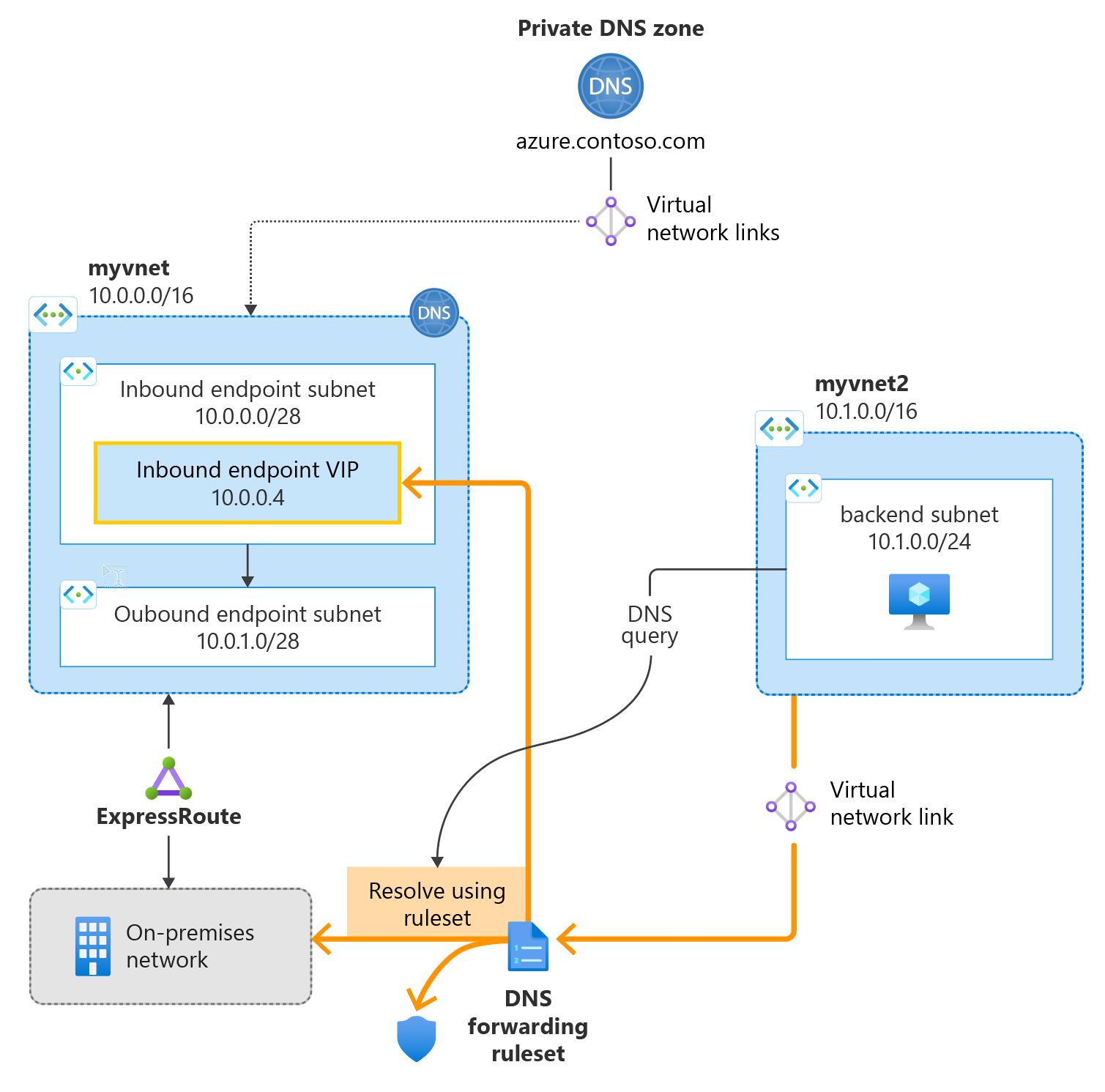本快速入門說明如何使用 Bicep 來建立 Azure DNS 私人解析器。
Bicep 是使用宣告式語法來部署 Azure 資源的特定領域語言 (DSL)。 其提供簡潔的語法、可靠的類型安全,並支援程式碼重複使用。 Bicep 能夠為您在 Azure 中的基礎結構即程式碼解決方案,提供最佳的製作體驗。
下圖摘要說明使用的一般設定。 範本中使用的子網位址範圍與圖中所示的子網位址範圍稍有不同。
必要條件
如果您沒有 Azure 訂用帳戶,請在開始前建立免費帳戶。
檢閱 Bicep 檔案
此快速入門中使用的 Bicep 檔案是來自 Azure 快速入門範本。
此 Bicep 檔案已設定為建立下列項目:
- 虛擬網路
- DNS 解析程式
- 輸入和輸出端點
- 轉送規則和規則集。
@description('name of the new virtual network where DNS resolver will be created')
param resolverVNETName string = 'dnsresolverVNET'
@description('the IP address space for the resolver virtual network')
param resolverVNETAddressSpace string = '10.7.0.0/24'
@description('name of the dns private resolver')
param dnsResolverName string = 'dnsResolver'
@description('the location for resolver VNET and dns private resolver - Azure DNS Private Resolver available in specific region, refer the documenation to select the supported region for this deployment. For more information https://docs.microsoft.com/azure/dns/dns-private-resolver-overview#regional-availability')
@allowed([
'australiaeast'
'uksouth'
'northeurope'
'southcentralus'
'westus3'
'eastus'
'northcentralus'
'westcentralus'
'eastus2'
'westeurope'
'centralus'
'canadacentral'
'brazilsouth'
'francecentral'
'swedencentral'
'switzerlandnorth'
'eastasia'
'southeastasia'
'japaneast'
'koreacentral'
'southafricanorth'
'centralindia'
'westus'
'canadaeast'
'qatarcentral'
'uaenorth'
'australiasoutheast'
'polandcentral'
])
param location string
@description('name of the subnet that will be used for private resolver inbound endpoint')
param inboundSubnet string = 'snet-inbound'
@description('the inbound endpoint subnet address space')
param inboundAddressPrefix string = '10.7.0.0/28'
@description('name of the subnet that will be used for private resolver outbound endpoint')
param outboundSubnet string = 'snet-outbound'
@description('the outbound endpoint subnet address space')
param outboundAddressPrefix string = '10.7.0.16/28'
@description('name of the vnet link that links outbound endpoint with forwarding rule set')
param resolvervnetlink string = 'vnetlink'
@description('name of the forwarding ruleset')
param forwardingRulesetName string = 'forwardingRule'
@description('name of the forwarding rule name')
param forwardingRuleName string = 'contosocom'
@description('the target domain name for the forwarding ruleset')
param DomainName string = 'contoso.com.'
@description('the list of target DNS servers ip address and the port number for conditional forwarding')
param targetDNS array = [
{
ipAddress: '10.0.0.4'
port: 53
}
{
ipAddress: '10.0.0.5'
port: 53
}
]
resource resolver 'Microsoft.Network/dnsResolvers@2022-07-01' = {
name: dnsResolverName
location: location
properties: {
virtualNetwork: {
id: resolverVnet.id
}
}
}
resource inEndpoint 'Microsoft.Network/dnsResolvers/inboundEndpoints@2022-07-01' = {
parent: resolver
name: inboundSubnet
location: location
properties: {
ipConfigurations: [
{
privateIpAllocationMethod: 'Dynamic'
subnet: {
id: '${resolverVnet.id}/subnets/${inboundSubnet}'
}
}
]
}
}
resource outEndpoint 'Microsoft.Network/dnsResolvers/outboundEndpoints@2022-07-01' = {
parent: resolver
name: outboundSubnet
location: location
properties: {
subnet: {
id: '${resolverVnet.id}/subnets/${outboundSubnet}'
}
}
}
resource fwruleSet 'Microsoft.Network/dnsForwardingRulesets@2022-07-01' = {
name: forwardingRulesetName
location: location
properties: {
dnsResolverOutboundEndpoints: [
{
id: outEndpoint.id
}
]
}
}
resource resolverLink 'Microsoft.Network/dnsForwardingRulesets/virtualNetworkLinks@2022-07-01' = {
parent: fwruleSet
name: resolvervnetlink
properties: {
virtualNetwork: {
id: resolverVnet.id
}
}
}
resource fwRules 'Microsoft.Network/dnsForwardingRulesets/forwardingRules@2022-07-01' = {
parent: fwruleSet
name: forwardingRuleName
properties: {
domainName: DomainName
targetDnsServers: targetDNS
}
}
resource resolverVnet 'Microsoft.Network/virtualNetworks@2022-01-01' = {
name: resolverVNETName
location: location
properties: {
addressSpace: {
addressPrefixes: [
resolverVNETAddressSpace
]
}
enableDdosProtection: false
enableVmProtection: false
subnets: [
{
name: inboundSubnet
properties: {
addressPrefix: inboundAddressPrefix
delegations: [
{
name: 'Microsoft.Network.dnsResolvers'
properties: {
serviceName: 'Microsoft.Network/dnsResolvers'
}
}
]
}
}
{
name: outboundSubnet
properties: {
addressPrefix: outboundAddressPrefix
delegations: [
{
name: 'Microsoft.Network.dnsResolvers'
properties: {
serviceName: 'Microsoft.Network/dnsResolvers'
}
}
]
}
}
]
}
}
此樣本中定義了七個資源:
- Microsoft.Network/virtualnetworks
- Microsoft.Network/dnsResolvers
- Microsoft.Network/dnsResolvers/inboundEndpoints
- Microsoft.Network/dnsResolvers/outboundEndpoints
- Microsoft.Network/dnsForwardingRulesets
- Microsoft.Network/dnsForwardingRulesets/forwardingRules
- Microsoft.Network/dnsForwardingRulesets/virtualNetworkLinks
部署 Bicep 檔案
- 將 Bicep 檔案以 main.bicep 儲存至本機電腦。
- 使用 Azure CLI 或 Azure PowerShell 部署 Bicep 檔案
az group create --name exampleRG --location eastus
az deployment group create --resource-group exampleRG --template-file main.bicep
當部署完成時,您應該會看到指出部署成功的訊息。
驗證部署
使用 Azure 入口網站、Azure CLI 或 Azure PowerShell 來列出資源群組中已部署的資源。
#Show the DNS resolver
az dns-resolver show --name "sampleDnsResolver" --resource-group "sampleResourceGroup"
#List the inbound endpoint
az dns-resolver inbound-endpoint list --dns-resolver-name "sampleDnsResolver" --resource-group "sampleResourceGroup"
#List the outbound endpoint
az dns-resolver outbound-endpoint list --dns-resolver-name "sampleDnsResolver" --resource-group "sampleResourceGroup"
清除資源
不再需要時,請使用 Azure 入口網站、Azure CLI 或 Azure PowerShell 以下列順序刪除資源。
刪除 DNS 解析器
#Delete the inbound endpoint
az dns-resolver inbound-endpoint delete --dns-resolver-name "sampleDnsResolver" --name "sampleInboundEndpoint" --resource-group "exampleRG"
#Delete the virtual network link
az dns-resolver vnet-link delete --ruleset-name "sampleDnsForwardingRuleset" --resource- group "exampleRG" --name "sampleVirtualNetworkLink"
#Delete DNS forwarding ruleset
az dns-resolver forwarding-ruleset delete --name "samplednsForwardingRulesetName" --resource-group "exampleRG"
#Delete the outbound endpoint
az dns-resolver outbound-endpoint delete --dns-resolver-name "sampleDnsResolver" --name "sampleOutboundEndpoint" --resource-group "exampleRG"
#Delete the DNS resolver
az dns-resolver delete --name "sampleDnsResolver" --resource-group "exampleRG"
下一步
在此快速入門中,您建立了一個虛擬網路與 DNS 私人解析器。 現在設定 Azure 和內部部署網域的名稱解析。
